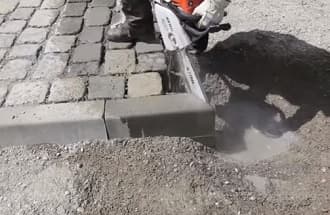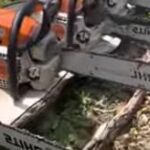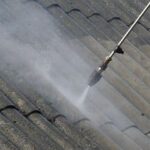As an Amazon Associate, this site earns commissions from qualifying purchases. For more information click here.
If you need to cut trees and logs, a chainsaw gets the job done nicely. But what if you have to break down some cement blocks or masonry? For that a standard chainsaw will not work. You need specially made cutters that can handle hard surfaces. And there are such tools available now.
A concrete chainsaw can cut concrete, rocks, metal, masonry and other hard surfaces. Its diamond coated blade makes it harder than a regular chainsaw. A water circulation system cools it down during the cutting process and prevents dust from flying everywhere.
Differences between a Concrete Chainsaw and a Regular Chainsaw
There are two things that set a concrete chainsaw apart from a regular chainsaw. One, its blades are coated with diamond grit and two, it uses water circulation instead of bar and chain oil.
Concrete chainsaws have diamond coating on the chain to make them harder. Regular chainsaw chains cannot cut concrete because it is too hard. By coating the blade with diamond grit, it becomes durable enough to cut through concrete, rock and other hard surfaces. The blades have also been specially designed to withstand hard surfaces.
If cutting wood makes chainsaws hot, concrete will be even harder on the motor. This is where the water circulation system comes in. The water cools the chainsaw down as it cuts. Without this cooling mechanism, the cutter will overheat.
If the chainsaw is not designed to cut concrete, the engine will overheat and smell like it is burning. This is why the water circulation is very important.
Water also dispenses dust and other debris. If you have ever cut logs with a chainsaw, you know how dusty it can get. The same thing happens if you cut concrete the same thing happens. Dirt and dust will be all over the chainsaw and you. The water circulation prevents dust from clogging the machine and slowing its operation.
How to Cut Concrete with a Chainsaw
A chainsaw may look similar to the regular ones you use, but there are important differences. The following is a step by step guide on how to use a concrete chainsaw. There are different models available but these are applicable to all models.
Step 1 Safety Precautions
Wear your safety gear. Thick gloves, steel toe or sturdy boots, eyewear protection, ear plugs, a helmet or hard hat, chaps and protective clothing. You have probably heard that concrete chainsaws do not have kick back which is true. But it is still a good idea to wear protective gear.
Inspect the concrete you are about to cut. Look out for cables, ducts and other objects that the chainsaw might run into. To avoid problems, clear the area first before doing any work.
This guide assumes that you have already read the owner’s manual. It is imperative that you familiarize yourself with the chainsaw before using it. Incidentally, if you are looking for a PPE kit, we like the Forester kit as it is complete and reliable.
Step 2 Prepare the Chainsaw
Concrete chainsaws must have water supply to prevent overheating. It also filters out dust and removes slurry. The water pressure has to be at least 4 liters per minute with a bar pressure of 1.5.
Adjust the chain tension so it is not too loose. But it must not be too tight either. You must be able to move the chain around the bar without producing too much slack. If the chain is about half an inch loose below the guide bar that is fine.
Step 3 Mark the Area to Cut
In this example you will be cutting into a concrete wall. You can make things easier by marking the spot where you will make the cut.
Mark the spot by cutting 1.6 inches deep. This is your marker. Start cutting from the bottom, then the top and the sides. This is the standard method used for cutting concrete and produces the fastest results. Keep your hand steady.
Step 4 Start Cutting
Point the blade to the wall. Set the throttle to full power. Plunge the guide bar into the wall, following the marker you made.
As you cut, minimize the free running RPM by 22-30%. Doing this provides the chainsaw with the right amount of force. Too much RPM and the blade will not be fast enough to cut through. It will also cause the engine to halt. Too little RPM and the chainsaw loses its cutting power.
As you start cutting you will know when you are applying the right force. If you are cutting through rebar, rock the tool a little. This is necessary to cut both concrete and metal.
Opening the chain diamonds accelerates the process and can help a lot. If you are going to cut a lot of masonry flip the bar over to ensure even results.
Do You Need a Concrete Chainsaw?
Most homeowners probably will not need a concrete chainsaw. Most tasks will be done with a Husqvarna 450 Rancher just fine. But if you are renovating your home or doing some kind of work that involves cutting concrete, this tool will come in handy. Concrete chainsaws are also fixtures in construction sites, mining operations and other industries.
If you need to cut something harder than wood, these chainsaws will do the job. They are particularly useful in certain emergency situations. If you need to break up cement walls or parts of concrete, this becomes an essential tool.
Buying a concrete chainsaw is something you need to think about first. If you rarely work with concrete or other hard materials, it is not required. But if your job – or your home renovation project – involves a lot of concrete, this is something worth considering.

How Does a Concrete Chainsaw Work?
A concrete chainsaw is equipped with diamond covered blade so it can cut rebar, concrete and other rough and hard materials. It looks a lot like a traditional chains, but its blade is much stronger. It also uses water circulation to cool the engine during operation.
A regular chainsaw uses oil to lubricate the bar and chain. With a concrete chainsaw, water is used for cooling purposes and prevent dust from scattering.
The diamond coating allows the chainsaw to cut other hard materials. Apart from concrete, you can use the saw to cut rocks, gypsum, apatite, calcite and more.
These chainsaws are not only versatile, but they are fast too. You can cut through a 1’ x 6” concrete in a couple of minutes. Of course if the material contains other components like metal, it will take longer.
The type of material you are cutting has an obvious effect. Limestone is easier on the blade than concrete with rebar for instance. When working with these hard surfaces, you have to strike the right balance between speed and force.
How Long Does a Concrete Chainsaw Blade Last?
The blade or chain on these chainsaws are built for long term use. There are a lot of factors that come into play. But a typical gas powered concrete chainsaw chain can go through 45-80 feet in 6 inch concrete.
The guide bar is good for 2-3 chains, but it can vary depending on the material being cut. A chainsaw cutting limestone is obviously going to last longer than one used on rebar. The more rebar, the shorter the chainsaw bar and chain life will be.
One thing to keep in mind is that concrete chainsaws must never be used without water. As explained earlier, water circulation is a must. Forcing the chainsaw to cut dry will damage the blade.
The chain tension directly affects performance. Usually these cutters work better when the chain is a bit loose. By loose that means the drive links are hanging about half an inch under the bar. If you are not sure, check your owner’s manual.
At this point you are probably wondering if you can just put a concrete chainsaw chain on your regular chainsaw. The answer is no, you cannot. These chains will not work properly without water circulation, and regular chainsaws are not built to handle water. Instead they use bar and chain oil.

I love the outdoors and all the tools for maintaining gardens, yards and lawns. The only thing I am more passionate about is sharing what I know about garden and outdoor equipment.


